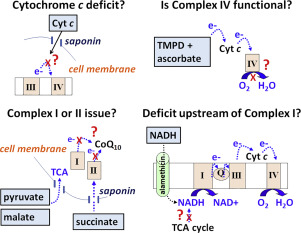当前位置:
X-MOL 学术
›
Exp. Neurol.
›
论文详情
Our official English website, www.x-mol.net, welcomes your feedback! (Note: you will need to create a separate account there.)
Mapping mitochondrial respiratory chain deficiencies by respirometry: Beyond the Mito Stress Test.
Experimental Neurology ( IF 5.3 ) Pub Date : 2020-03-09 , DOI: 10.1016/j.expneurol.2020.113282 Sausan M Jaber 1 , Nagendra Yadava 2 , Brian M Polster 1
Experimental Neurology ( IF 5.3 ) Pub Date : 2020-03-09 , DOI: 10.1016/j.expneurol.2020.113282 Sausan M Jaber 1 , Nagendra Yadava 2 , Brian M Polster 1
Affiliation

|
Cell-based respirometers, such as the Seahorse Extracellular Flux Analyzer, are valuable tools to assess the functionality of mitochondria within adherent neurons, as well as other cell types. The Mito Stress Test is the most frequently employed protocol of drug additions to evaluate mitochondrial bioenergetic function. Sequential exposure of cells to an ATP synthase inhibitor such as oligomycin and an uncoupler such as FCCP cause changes in oxygen consumption rate that allow estimation of the cellular efficiency and capacity for mitochondrial ATP synthesis. While a useful first step in assessing whether an experimental treatment or genetic manipulation affects mitochondrial energetics, the Mito Stress Test does not identify specific sites of altered respiratory chain function. This article discusses limitations of the Mito Stress Test, proposes a refined protocol for comparing cell populations that requires independent drug titrations at multiple cell densities, and describes a stepwise series of respirometry-based assays that "map" locations of electron transport deficiency. These include strategies to test for cytochrome c release, to probe the functionality of specific electron transport chain complexes within intact or permeabilized cells, and to measure NADH oxidation by the linked activity of Complexes I, III, and IV. To illustrate utility, we show that although UK5099 and ABT-737 each decrease the spare respiratory capacity of cortical neurons, the stepwise assays reveal different underlying mechanisms consistent with their established drug targets: deficient Complex I substrate supply induced by the mitochondrial pyruvate carrier inhibitor UK5099 and cytochrome c release induced by the anti-apoptotic BCL-2 family protein inhibitor ABT-737.
中文翻译:

通过呼吸测定法绘制线粒体呼吸链缺陷的图:超出Mito压力测试。
基于细胞的呼吸计,例如Seahorse细胞外通量分析仪,是评估粘附神经元以及其他细胞类型内线粒体功能的重要工具。Mito压力测试是最常用的药物添加方案,用于评估线粒体的生物能功能。将细胞顺序暴露于ATP合酶抑制剂(例如寡霉素)和解偶联剂(例如FCCP)会导致耗氧率发生变化,从而可以估算细胞效率和线粒体ATP合成能力。虽然评估实验治疗或基因操作是否影响线粒体能量的有用的第一步,但线粒体压力测试并未发现呼吸链功能改变的特定部位。本文讨论了Mito压力测试的局限性,提出了一种用于比较需要在多种细胞密度下进行独立药物滴定的细胞群体的改进方案,并描述了一系列基于呼吸测定的分析方法,这些步骤可“映射”电子转运缺陷的位置。这些方法包括测试细胞色素c释放,探测完整或通透的细胞内特定电子转运链复合物的功能以及通过复合物I,III和IV的联结活性来测量NADH氧化的策略。为了说明其实用性,我们表明尽管UK5099和ABT-737各自都会降低皮质神经元的备用呼吸能力,但逐步分析揭示了与其既定药物靶标一致的不同潜在机制:
更新日期:2020-03-09
中文翻译:

通过呼吸测定法绘制线粒体呼吸链缺陷的图:超出Mito压力测试。
基于细胞的呼吸计,例如Seahorse细胞外通量分析仪,是评估粘附神经元以及其他细胞类型内线粒体功能的重要工具。Mito压力测试是最常用的药物添加方案,用于评估线粒体的生物能功能。将细胞顺序暴露于ATP合酶抑制剂(例如寡霉素)和解偶联剂(例如FCCP)会导致耗氧率发生变化,从而可以估算细胞效率和线粒体ATP合成能力。虽然评估实验治疗或基因操作是否影响线粒体能量的有用的第一步,但线粒体压力测试并未发现呼吸链功能改变的特定部位。本文讨论了Mito压力测试的局限性,提出了一种用于比较需要在多种细胞密度下进行独立药物滴定的细胞群体的改进方案,并描述了一系列基于呼吸测定的分析方法,这些步骤可“映射”电子转运缺陷的位置。这些方法包括测试细胞色素c释放,探测完整或通透的细胞内特定电子转运链复合物的功能以及通过复合物I,III和IV的联结活性来测量NADH氧化的策略。为了说明其实用性,我们表明尽管UK5099和ABT-737各自都会降低皮质神经元的备用呼吸能力,但逐步分析揭示了与其既定药物靶标一致的不同潜在机制:



























 京公网安备 11010802027423号
京公网安备 11010802027423号